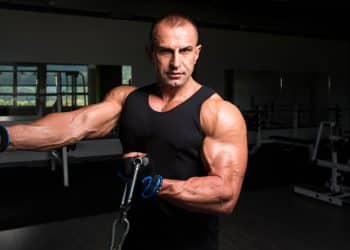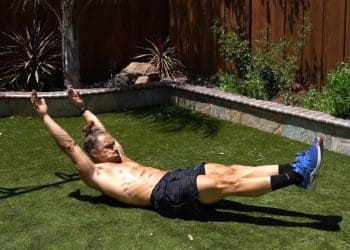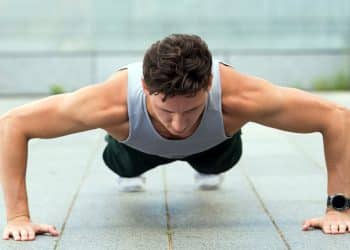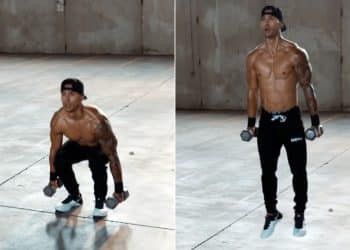The suspension jump squat is an assisted athletic-based bodyweight exercise that combines resistance, speed, and power training, as well as physical conditioning. Both as a fitness professional and someone who’s put various training methods through the ringers, my first thought about this movement is the principle of specificity (POS).
What’s POS?
In short, performance research and real-world evidence suggest that your training should simulate the activities you strive to excel at. For example, the suspension jump squat is the perfect exercise for someone who wants to develop explosive hopping power, while conditioning their body and heart muscles for sports or performance-related activities.
But the suspension jump squat has so many more potential benefits, not to mention, it’s just fun to do! (Who can’t use more excitement in their training?). Let’s jump into this full body exercise that targets various areas of fitness.
How To Do The Suspension Jump Squat
Suspension jump squats are not an exercise that just anyone should hop (Pun intended) into. If you do it wrong, your body could pay the price sooner or later. To ensure the health of your joints and long term training goals, we explained the suspension jump squat technique with detailed step by step training instructions below.
You’ll also find a video demonstration with expert technique tips, which are also included in written format for your convenience.
Level Up Your Fitness: Join our 💪 strong community in Fitness Volt Newsletter. Get daily inspiration, expert-backed workouts, nutrition tips, the latest in strength sports, and the support you need to reach your goals. Subscribe for free!
Before you hop into this exercise though, we do recommend warming up your joints and muscles for ten minutes with light activity.
Now it begins..
Step 1: Strap setup
Anchor your suspension trainer to a sturdy object taller than your head. You can use a training rack, pull-up bar, tree branch, etc.
Adjust your straps length so the ends (Or handles) hang down around your knees when standing up. Note: This is merely a suggestion based on general expert recommendation. Feel free to adjust your strap height as you find fitting.
Step 2: Getting into position
Facing the anchor point, grab both handles with a neutral grip, bend your arms at 90 degrees, and walk backward to lengthen the straps. Then determine the appropriate stance (About shoulder width apart for most people), and point your feet straight forward.
Standing mostly upright, lean back at a slight angle so the straps are supporting some of your body weight but not too much. This will keep tension on the straps as it moves in an arcing motion which maximizes movement efficiency.
Step 3: Squat
Squeeze your midsection to stabilize your spine, then bend your knees and drop your butt down until your thighs are parallel to the floor or slightly lower. Your arms should naturally flex forward.
Then powerfully extend your hips, knees, and ankles to propel yourself upward in the air. Simultaneously flex your lats, pull the straps down toward the ground and extend your arms for maximum elevation.
Step 4: Stick the landing
Landing is as important as the takeoff.
For the safety of your knees, as you drop down to the floor, always land on your toes first, then simultaneously bend your hips and knees for proper force absorption.
Step 5: Do it again!
Now you’re an expert in the suspension jump squat. Finish out your set, rest for a minute and a half then repeat two more times, or as appropriate for your training goals.
Suspension jump squat video tutorial
If you’ve got a few minutes to spare and want to see how the suspension jump squat looks in motion, check out the video tutorial below this for a detailed demonstration with pro movement tips.
Tips
- For pure power and explosiveness, practice 3-4 rep sets and focus only on using max leg power to jump as high as you can.
- You can squat low, however, perform the negatives slower than your jumps for the sake of your knee health.
- Make sure to wear quality training shoes.
- Always warm up your muscles and joints before jumping into an exercise like this one.
- You can also use ropes, resistance bands, or anything that offers assistance similar to suspension straps.
This Exercise
- Target Muscle Group: Legs
- Type: Strength, athletic fitness
- Mechanics: Compound
- Equipment: Suspension setup
- Difficulty: Intermediate
Muscles Worked During The Suspension Jump Squat
More muscles help you explode off the ground than you think, and we’ll prove it with the anatomy of a jump squat below.
Quadriceps – Muscular quadriceps are the product of squat mechanics, aka knee and hip movement. You don’t need to do a super deep squat either to activate the five-headed quads in the front upper thigh. In fact, it’s more efficient to squat down until your thighs are parallel to the floor or slightly lower for optimal explosive jumping power.
However, it’s important to note that you can modify suspension jump squats to fit your goals. The primary variation talked about in this guide is more of an all-around technique. Whereas if you want more power and jumping speed, you can can do that too.
Hamstrings – Below your bum are three hamstring muscles that tie into both the hip and knee joints behind your body. The hamstrings do the opposite of quads, bending the knees, and straightening the body from the hips.
Hips – Primarily referring to the most prominent hip flexor muscles, iliopsoas, that bends the leg at the thigh and lifts the knee higher than the waist.
Core – A strong core makes everything better, and like your legs, creates a strong base for physical activities. In lifts, a capable core prevents collapsing under weight loads, and
Calves – Below the knee, your calves have their own athletic purpose to explosively extend the ankle and push the toes down into the floor to propel you off the ground.
Benefits of The Suspension Jump Squat
Suspension jumps are a package deal that gives you several benefits from various training modalities all in one technique. Let’s talk about the benefits you should expect from this plyo based movement.
Increase explosive power and sports performance
While jump squats probably won’t increase your weighted squat unless you’re a training newb, it’s a plyometric technique for functional strength, and performance.
Remember that POS is based on doing the thing that you want to be good at. Jump if you want to jump higher, train longer for endurance, swing if you want an efficient swing, and lift heavier if you want stronger muscles.
Plyometrics are typically bodyweight only and a minimalist approach to training that focuses on fast, intense movements. The side effects of this exercise style include increased explosive muscle power, muscle quickness, improved joint and muscle stability, balance, coordination, situational awareness, and so forth.
If you’re not going to engage in sporting activities or other high intensity workout, suspension jump squats are sort of a nice lower body do it all option.
Check out the 10 Best plyometric exercises to build explosive power.
Maintain your leg development
Jumping is an alternative way to build and condition your leg muscles, but it may also help to maintain your gains when you can’t get to a gym, or you want to take a short break from traditional lifting.
One study from 2022 concluded that jump training induces muscle growth. However, more so for non-athletes, and likely less experienced exercisers. And higher training frequency is likely correlated with better results (1).
Keep in mind though, the aformentioned study is limited, as it did not consider many other variables that could influence the results.
Level Up Your Fitness: Join our 💪 strong community in Fitness Volt Newsletter. Get daily inspiration, expert-backed workouts, nutrition tips, the latest in strength sports, and the support you need to reach your goals. Subscribe for free!
Take advantage of assistance
Unlike a free balancing variation, the assisted aspect of suspension jump squats are great for building confidence. They help guide, balance, and focus on form which makes them more beginner friendly and possibly a good option for rehabbing purposes.
But at the same time, suspension trainers are famous due to the fact that they’re a more unstable training platform. So while it assists, you’re also improving the most necessary functional elements of physical movement.
Strip off body fat
One thing is certain, suspension jump squats are an efficient all-in-one exercise that blends several elements of fitness and performance. While it’s not the most sustainable calorie burning exercise due to its’ high intensity, high impact nature, jumps are an athlete’s activity. That means you’ll be sweating and using more energy which equals more fat loss potential.
You’ll of course need to factor in your daily calorie intake, and determine the optimal energy output to achieve your weight loss goals.
Combine your training with a fat burner for more pounds dropping effect!
Get mentally strong
You’re never just fighting the resistance, but also the lactic acid, tiredness, etc. Squats can test your desire to train as it is, then add in explosive jumps and you’re training to be a warrior. Challenge yourself to achieve the same squat depth on every rep, and don’t back down when it hurts.
Dodge injuries
While jump training can actually help your agility, hence dodging obstacles, it’s, in some form, one of the exercise strategies used in some rehab training regimes. Along with box jumps and other jump movements.
It helps to strengthen the physical structures responsible for bodily movement, and weight bearing is an essential part of recovery. It can be a double edged sword because your form needs to be on point or you could sustain further injuries.
But you should always perform rehabbing activities under the supervision of a medical professional anyway.
Common Mistakes During The Suspension Jump Squat
Some training sins are more forgivable than others, however, when it comes to jumping techniques, you may not have many chances for redemption. Take a look at the bad habits to avoid below.
Hard landing
While it’s okay for planes, our joints are not designed for hard landings. Oftentimes inexperienced exercisers are unaware of how to absorb a jump and it can cause the hips, knees, and ankles to take a beating. Over time, this could cause structural breakdown, injuries, and a lower quality of life. It may sound dramatic, but it’s a fact.
You have to find the natural balance between softening the joints to lessen the force of landing impact, while not dropping too harshly into a squat. That brings us to the next don’t…
Speeding through the negatives
When you land, avoid crashing your weight down into a low squat but rather, use muscle control for every part of the repetition. Failure to do this can create dangerous amounts of force on the knees especially, if you’re careless. But you can also open yourself to ankle sprains.
Short squats
If you can’t squat down at least halfway, then you’re probably not ready for suspension jump squats anyway. While you don’t need to be a top athlete or advanced trainee to do it, you should have adequate joint mobility, with the ability to squat, and drive with force into the floor, before absorbing the landing.
Variations and Alternatives Of The Suspension Jump Squat
While it doesn’t get much better than suspension jump squats for what they offer, we have some similiar variations for other training benefits.
Suspension weighted jump squats
Adding more resistance to suspension jump squats will amplify all of the benefits mentioned above. Just don’t overdo it, and know your limits. Increase the weight gradually in smaller increments to safely progress your gains.
So how do you add weight to a jump squat?
We recommend using a weighted vest over ankle or wrist weights. Vests carry the weight on your center mass, and may be better supported by the larger muscles in your torso. Whereas there are mixed opinions on using joint weights for higher impact activities for two reasons.
“They’re great for specific exercises, but they have some risks,” says Terry Downey, a Physical Therapist at Harvard-affiliated Spaulding rehabilitation network.
Ankle weights may cause you to activate more quadriceps and less hamstrings while walking. Which, if done enough, could cause muscle imbalance in the thigh. Additionally, the load is typically right at the ankle which pulls on the contents around ankle joint.
And while a weighted vest may be a better choice, avoid them if you have back or neck problems, and they shouldn’t weigh more than 10 percent of your body weight.
Suspension single leg jump squats
Only after you’ve mastered the two legged version should you attempt suspension single leg jump squats. It requires much more balance, joint stability, muscle control, and coordination. You can easily hurt something, or twist an ankle if you’re not careful especially when hopping on one leg.
But… if you can nail this movement, the results will be out of this world. You can easily build more leg muscles, power and strength, and you’ll be the ultimate athlete! Note: You probably won’t be able to jump as high since you don’t have help from the other leg. But that’s okay because you can challenge yourself to increase leaping height.
Adhere to the same training advice provided for the primary two legged variation.
Pro tip: You must take the eccentric phase (When you squat down) slower to maintain safe joint alignment.
Suspension jump squats w/ knee tuck
Boost your suspension jump squats with knee tucks. As you jump up, simply lift your knees as high and quickly as you can. What’s the added benefit of this variation? Well, you’re adding another explosive technique in there by consciously trying to push off the floor faster.
You could possibly activate even more of your fast twitch muscle fibers, which are larger and more powerful than the slow twitch endurance fibers.
Fast forward the following video to the 25-second mark to see suspension jump squats with knee tucks.
Box jumps
As an alternative, you could do box jumps, which are even safer on the joints. Why is that? Because there’s a shorter distance from the height of your jump to the landing. And gravity is more forgiving since you’re landing in the air, and not falling back down to earth, or the gym floor.
Don’t have a box but want to build one? Here’s the best (& easiest) 3-in-1 DIY plyo box for your home gym.
Alternatively, find a chair, stairway, or anything that’s safe to hop up on.
FAQ’s
How should I program sets and reps?
That’s going to depend on your training goals, tempo, effort, technique, etc.
For example, if you’re deep squatting and using more muscle fibers, lactic acid, the stuff that causes the painful burning during exercise, will have its way with you rather quickly.
But if you’re only squatting partially with a fast tempo, you may be able to squeeze out a higher rep range. It’s up to you.
But you can do 2-3 sets of 10-20 reps for general, all-around benefits and conditioning focus, or try 2-3 sets x 3 reps for pure power and speed training.
How often should I do Jump squats?
Unless you’re a high performance athlete, I’d say to limit your sessions to 1-2 per week. Especially if you’re including other similar activities for lower body performance.
Who should avoid jump squats?
While we hate to leave anyone out, certain people should reconsider, or opt for a lower impact option.
If you have knee or hips problems, are very overweight, or just starting exercise activity, we recommend choosing different forms of exercise that don’t involve leaping and landing.
Wrapping Up
Become a performance machine by incorporating this beginner level jump technique in your leg training days. You want to be a more powerful athlete? Need to drop pounds and improve heart strength? Or maybe you’re short on time but need an all-in-one workout. Suspension jump squats are an incredible total body exercise with more benefits than we can name.
Don’t have suspension straps? While they are a luxury, you don’t need them to achieve similar benefits. Check out our variations and alternatives section for effective substitutes.
Interested in measuring your progress? Check out our strength standards for Squat.












